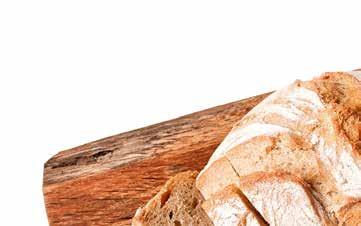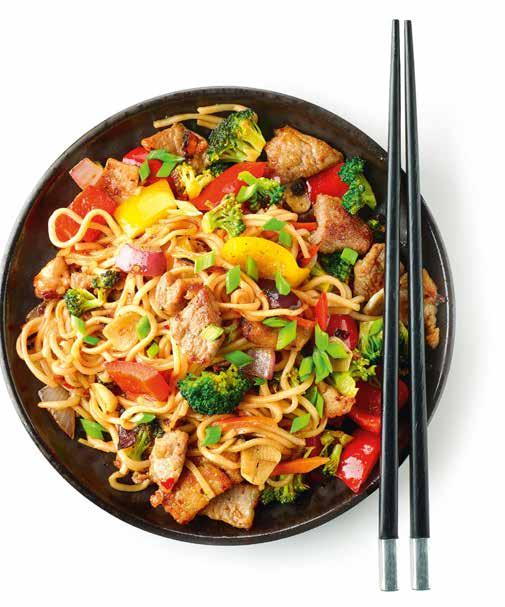
4 minute read
Allergens… all you need to know
Before the new legislation arrives in October, we’re looking at each allergen in detail. To download and print the allergen factsheets, head to our website: brws.it/allergenpack
Allergens: gluten and lupin
In the latest of the series, we look at one of the most well-known allergens and one of the lesser known
10 GLUTEN
Gluten is the name for the proteins found in wheat that help it maintain its shape. As many as 13% of the population avoid this well-known allergen. For some, it’s because of a diagnosed allergy, while others choose to avoid gluten for lifestyle reasons.
Reactions to gluten can be immediate or delayed. The most common eff ects are bloating, abdominal pain and diarrhoea but can also include headaches, fatigue, depression and weight loss over time.
The body’s response to gluten proteins can cause coeliac disease, a condition where the immune system attacks the tissues, damaging the gut and making it impossible to take in nutrients.
Look out for:
• Some frozen chips contain gluten • Oats are not always gluten-free due to the way they are processed. Always check • Avoid grains and wheat-based ingredients such as couscous, bulghur wheat, barley, semolina and rye • Crisps are one to double check. Salt and vinegar fl avour, in particular, may use barley malt fl avouring • Look out for sausages and burgers that are bulked out with breadcrumbs, and battered meat or fi sh • Warn your regulars that beer, ale, stout and lager may contain gluten. Some people with gluten allergies won’t drink vodka as it’s disputed whether allergies won’t drink vodka as it’s disputed whether it contains the allergen or not • Common ingredients such as soy sauce, stock cubes and mustard can have gluten in them. Also be cubes and mustard can have gluten in them. Also be cautious about ready-made gravies and sauces as cautious about ready-made gravies and sauces as these too may contain gluten.
Gluten substitutes
The gluten-free market is huge with substitutions for almost any foods you can think of: • There are tasty pasta alternatives made from rice, corn, tapioca or buckwheat • Cornfl our can make a good substitute to wheat fl our in sauces such as gravy • Breads such as pitta, croissants, naans, bagels and wraps can be switched for good quality gluten-free breads. Try rice, corn and buckwheat-made crackers and crispbreads, too – great for a cheeseboard • Replace wheat-based breakfast bowls and bars with gluten-free oat-based porridge and granola • There is now a multitude of fl our substitutes, from chestnut to rice to coconut. They react diff erently to wheat fl our and you often need to add a ‘gluing’ agent such as xanthan gum to obtain the desired texture, especially in baking • Try replacing couscous with quinoa. It is super • Try replacing couscous with quinoa. It is super healthy and gives a similar look and texture healthy and gives a similar look and texture • Tamari is the perfect substitute for soy sauce. • Tamari is the perfect substitute for soy sauce.
The salt levels can diff er so always taste to The salt levels can diff er so always taste to check seasoning. check seasoning.
The facts:

Around 1 in 100 people worldwide have coeliac disease while the numbers suffering with non-coeliac gluten sensitivity may be significantly higher The majority of people with gluten-related disorders remain undiagnosed Increasingly, gluten-free options are expected when eating out. Highlight your gluten-free options on the menu and online
find out more
Get recipes and more info on Coeliac UK’s website: coeliac.org.uk

11 LUPIN
next issue
Mustard, sulphur dioxide and celery
It is the least well-known allergen, however, it can provoke a serious reaction – so what exactly is lupin? Best known as a tall, colourful garden fl ower, the seeds from certain lupin species are crushed to make fl our, pastries, pancakes and pasta.
These seeds are one of the world’s richest known sources of combined plant protein (around 40%) and dietary fi bre (30%).
It’s most often used in Mediterranean cuisine in mainland Europe. However, lupin is growing in popularity among pastry chefs because of its earthy fl avour and it is also a good source of plant protein for the gluten-intolerant.
Although it is far less common than some of the other allergies, it can be potentially as serious as a peanut allergy. In fact, some research suggests there is a link between lupin and peanut allergies as there is a similar protein in both and they’re from the legume family.
Symptoms of a lupin allergy can show rapidly and range from mild hives on the body to the less common breathing problems or anaphylactic shock.
Look out for:
• Lupin can be found in salad dressings, breads, pizzas, pastries and pancakes.
find out more
Always refer to the Food Standard Agency’s website for the most up-to-date allergen information: brws.it/fsa









